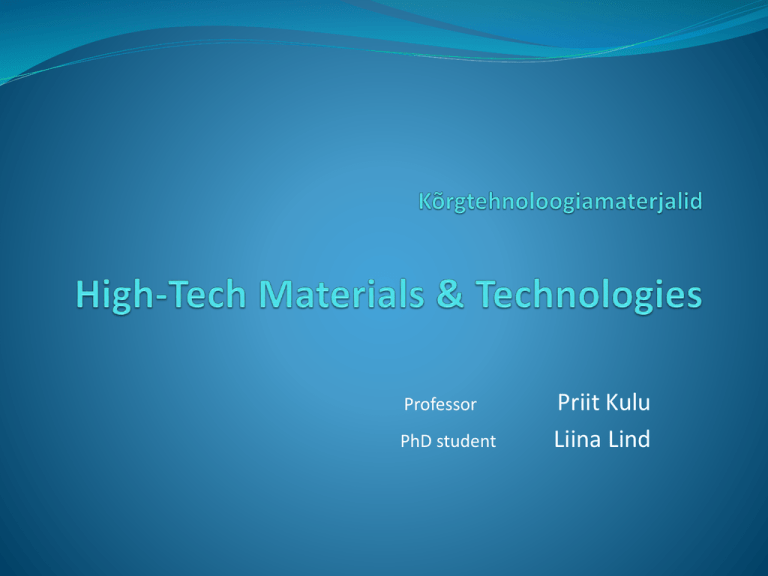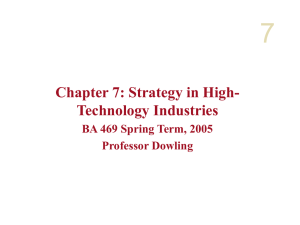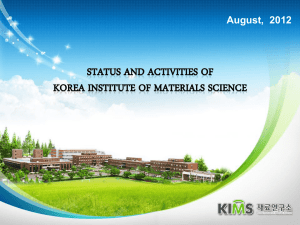High-Tech Materials & Technologies
advertisement

Professor PhD student Priit Kulu Liina Lind Outline 1. Introduction advanced materials in different areas trends & priorities 2. Advanced Materials metals, ceramics, composites & hybrids, carbon-family 3. Advanced materials technologies powder technology, casting, forming, machining High-Tech Materials & Technologies 2 1. Introduction advanced materials in different areas trends & priorities Advanced Materials 2. metals, ceramics, composites & hybrids, carbon-family Advanced materials technologies 3. powder technology, casting, forming, machining High-Tech Materials & Technologies 3 High-Tech (Advanced) Materials High-Tech Materials & Technologies 4 Definition State-of-art materials and coatings Technology based on recent achievements in physics, chemistry and biology Characterized by knowledge-intensity and process complexity Involving first of all manufacturing of coatings and novel ceramic & composite materials. High-Tech Materials & Technologies 5 Main material groups Metals & Alloys Metals Cermets Ceramics Ceramics MCM CCM Polymers Glass-ceramics GCCM Composites PCM FRG Polymers Glass Composites MCM CCM PCM GCCM FRG High-Tech Materials & Technologies Metal composite materials Ceramic composite material Polymeric composite material Glass-ceramic composite material Fiber-reinforced glass 6 Materials in a passenger car Polymers ~10% ACORD report from 2001 and BMW 7-series 2002-2008 Weight % of metals is decreasing, growing importance of polymers Ferrous + non-ferrous Polymers ~15% Elastomers 4% Thermosets 3% Glass Fuel, oil 6% 1% metals 68+8=76% Others (textile etc.) 3% Passenger car compostion in 2001 [ACORD, Annual Report 2001] Multimaterials 3% Thermoplastics 8% Metals 48+24=72% Low-weight metals and alloys (Al-frame) 24% Steel 48% (high-strength steel) BMW 7-series 2002-2008 High-Tech Materials & Technologies 7 Trends in aviation High-Tech Materials & Technologies 8 Materials in aviation Materials used in 787 Dreamliner, Boeing [Boeing AERO magazine 2006 boeing.com/commercial/aeromagazine/articles/qtr_4_06] High-Tech Materials & Technologies 9 Materials in medical applications Numerous biocompatible materials have found a place in medical applications Hip joints Dental implants Heart valves etc. Ceramic (Ti-alloy) Biocompatible coating High-Tech Materials & Technologies 10 Materials in building and mechanical engineering High-Tech Materials & Technologies 11 Historical ages of materials Cu (COPPER) STONE BRONZE 1 STONE, WOOD 2 COPPER, IRON 3 POLYMERS 4 IRON POLYMERS CERAMICS (STONE) TAILORED MATERIALS (composite materials) High-Tech Materials & Technologies 12 Materials R&D directions (European Technology Platform) metallic structural materials & metal-matrix composites (MMC), non-metallic structural materials (ceramics) & ceramic-matrix composites (CMC), polymers & polymer-matrix composites, multimaterials (e.g. hybrids), conductive and magnetic materials, biomaterials, packaging materials, lifecycle planning and reuse of materials High-Tech Materials & Technologies 13 Main trends (1) Growing applications for ceramics, polymers and composites → use of metals is decreasing Growing multidisciplinary collaboration (e.g. physics, chemistry, biology) → synthesis and processing of new materials High-Tech Materials & Technologies 14 Main trends (2) Sustainable development Sustainable technologies GRAPHICAL EXAMPLE FROM Mitsubishi Electric Group Environmental Vision 2021 in other words: REDUCE REUSE RECYCLE High-Tech Materials & Technologies 15 Priorities of R&D (1) 1. Weight reduction 2. Low cost 3. High-temperature applications 4. Biocompatibility (for implants) 5. Multifunctionality and intelligence High-Tech Materials & Technologies 16 Priorities of R&D (2) 6. Bioinspired materials – learning from nature Field known as: biomimetics, bionics, biomimicry Materials with lotus-leaf effect Velcro inspired from burdock Shark-skin inspired Speedo fastskins High-Tech Materials & Technologies 17 Priorities of R&D (3) 7. Computational simulating (e.g. Stress, crack propagation and molecular dynamics in nanoscience) A three-dimensional model reproducing crack shapes. The colors indicate the strength of local tensile stress. The crack opening is exaggerated 100 times. Intricate crack shape typical of stress corrosion cracking High-Tech Materials & Technologies Itakura et al. (2005) Phys. Rev. E, 71 18 Priorities (4) Down-sizing (e.g. Moore’s law) ...and sizing up (selfassembly is very common in biological 8. systems) THE NUMBER OF TRANSISTORS PER CHIP DOUBLE EVERY 18 MONTHS Scheme of the self-assembly of the Tobacco Mosaic Virus High-Tech Materials & Technologies 19 Introduction 1. advanced materials in different areas trends & priorities 2. Advanced Materials metals, ceramics, composites & hybrids, carbon-family Advanced materials technologies 3. powder technology, casting, forming, machining High-Tech Materials & Technologies 20 Advanced metallic materials Metallic materials with superior properties Structural alloys Mg- and Al-alloys with superior properties, Al-metaglass, foams Superconductive NbTi, Nb3Sn, Nb3Ge Neodymium rare-earth magnets (alloys of Nd, Fe and B) are strongest known permanent magnets. Sm-Co magnets Ti-alloys with thermomechanical properties, superalloys, maraging steels, intermetallides, high-density alloys, shape-memory alloys Biocompatible Ti-alloys High-Tech Materials & Technologies Amorphous alloys with chemical and thermal properties, Ni- and Fe aluminates 21 Advanced ceramic materials Oxidation resistant, chemically inert, electrically insulating, generally low thermal conductivity, Manufacturing: alumina – slightly complex & low cost, zirconia – more complex & higher cost Oxide ceramics alumina, zirconia (Al2O3) Low oxidation resistance, chemically inert, electrically conducting, high thermal conductivity, extreme hardness Manufacturing: Difficult & high cost Non-oxide ceramics carbides, borides, nitrides, silicides (Si3N4, SiC, B4C) Composites particulate reinforced, combinations of oxides and non-oxides High-Tech Materials & Technologies 22 Advanced ceramic materials Special oxide ceramics Electroceramics Optical ceramics Non-oxide structural/tool ceramics Mechanical and thermal properties Chemical and thermal properties Magnetic ceramics Radiation resistance Biocompatible ceramics High-Tech Materials & Technologies 23 Ceramics for tools and parts Oxides: SiO2, AlO3, ZrO2, MgO-based mullite (3Al2O3*2SiO2) Carbides: WC, Cr3C2, TiC, SiC, SiC, TiC – SHS process (e.g. Si&C or Ti&C compounds) Nitrides: Si3N-based, AlN Composites: Ti(C,N), SiAl(OH) (sialon)-based High-Tech Materials & Technologies 24 Toughness-hardness of ceramics Property Type of ceramic , kg/m3 HV*, GPa K1C, MPa*m0,5 WC 15800 24 6 Si3N4 (hot-pressed) 3200 16 5 Si3N4 (reactive 3200 8 22 2700 6 0,7 sintered) SiO2 (quartz) High-Tech Materials & Technologies 25 Strength – toughness of ceramics High-Tech Materials & Technologies 26 Metallic-ceramic tool and structural materials Carbide-steels and -alloys Ferro-TiC Steel (50 - 70)% -TiC Double reinforced MMC (Cr-steel + 20%VC) + 20%WC Self-fluxing alloys NiCrSiB + 50% (WC-Co) TiC-NiMo – (50 - 60)% (NiMo)(2:1) 920 – 1620 HV10 Cr3C2-NiCr – (50 - 60)% NiCr High-Tech Materials & Technologies 27 Metallic-ceramic tool materials Some examples of carbide cermets WC-Co – (6 - 30)% Co (hardmetals) 890 - 1430 HV10 Cr3C2-Ni – (10 - 30)% Ni 880 - 1360 HV10 TiC-Ni-Mo – (30 - 40)% NiMo(2:1) 920 - 1260 HV10 TiC-steel – (30 - 40)% austenitic/martensitic steel, 1050 - 1350 HV30 High-Tech Materials & Technologies 28 Hardness-toughness of materials 1. CERAMICS 3 2 Hardness 1 2. WHITE CAST IRON 3. CERMETS 4 5 6 4. METAL MATRIX COMPOSITES (MMC) 5. TOOL STEELS 6. CARBON AND STAINLESS STEELS Toughness High-Tech Materials & Technologies 29 Advanced composites Special purpose Structural / tool Electrocomposites (PM, CM) Mechanical properties (PM, CM) Optical (PM) Thermomechanical properties (CM, CaM, MM) Biocompatible (CaM, PM, CM) Radiation resistance (CM, CaM) PM – polymer matrix MM – metal matrix CM – ceramic matrix CaM – carbon matrix High-Tech Materials & Technologies 30 Typical structures of composites Particle reinforced Short fibre reinforced Continuous Sandwich-type fibre reinforced Coated High-Tech Materials & Technologies 31 Typical structures of coatings Mono Multilayer Composite Gradient Atomic layer Duplex High-Tech Materials & Technologies 32 Coating thickness and process temperatures of selected coating technologies [Reference] High-Tech Materials & Technologies 33 Carbon based materials Carbon family graphite, diamond, fullerens, carbon nanofibers (CNF) & tubes (CNT), diamond-like-carbon (DLC) coatings 34 Working temperature of various structural materials Specific strength Heat-resistant TMT alloys Ti-composites Superalloys Titanium Not heat-resistant Monocrystals Force-crystallized eutectic fast-hardened alloys Ceramics /graphite Graphite TiAl alloys Sintered alloys Al- alloy composites High-melting-point alloys Operating temperature (°C) High-Tech Materials & Technologies 35 Processing methods for selected materials Material system Form of material Processing method Metal-ceramic Bulk Casting, spraying, sintering, SHS Metal-polymer Coating Thermal spraying, PVD, CVD Ceramic-polymer Fibre Metal-ceramicpolymer Powder High-Tech Materials & Technologies Deposition, grinding, spraying 36 Introduction 1. advanced materials in different areas trends & priorities Advanced Materials 2. metals, ceramics, composites, carbon-family, hybrids, intelligent materials 3. Advanced materials technologies powder technology, casting, forming, machining High-Tech Materials & Technologies 37 Material technologies Production of materials, Processing of materials, Manufacturing of products Advanced materials technologies Powder technologies Casting Forming Machining Rapid Prototyping Joining technologies High-Tech Materials & Technologies 39 Powder technology in materials engineering High-Tech Materials & Technologies 40 Powder metallurgy (PM) Associated primarily with automotive industry → (e.g. in 2004 an average car in USA had 19,5 kg of PM details new engines 12 kg of PM details) Powders – prealloyed powders, fine dopants – Ni (1 – 2) m Technologies – powderforging (PF), e.g connecting rods Materials - 7,75 g/cm3 – gears PM details replace mechanically processed and moulded details PM Al- and Ti-alloys replace casting and forging High-Tech Materials & Technologies 41 PM/HIP Powder Metallurgy / High Isostatic Pressing Advantages: • Very fine microstructure and isotopic properties 1. Inert gas atomizing enables UT, to produce powder insucseptible to hydrogen brittleness (HISC) • others close to “product-shape”, flexible construction, good mechanical properties, small series 2. Sheet metal capsules are filled with the powder 3. The capsules are subjected to high isostatic pressure and high temperature to obtain full density High-Tech Materials & Technologies 42 SF /HIP Similar to PM/HIP, slab formation by spraying methods High-Tech Materials & Technologies 43 Processing of hybrid materials 100% ceramics 100% metal valu SD TS HIP SPS SHS * SD – Spray Deposition; HIP – High Isostatic Pressing; SHS – Selfpropagated High-temperature Synthesis; SPS – Spray Plasma Sintering High-Tech Materials & Technologies 44 Comparison of processing technologies of hybrid materials Casting SD HIP SHS SPS Particle size, m Large 500-1200 <1500 <300 <300 Shape Unlimited Limited Somewhat limited Limited Limited Ceramic % 5-15 <15-20 100 40-100 0-100 Microstr. Coarse Fine Fine Fine Fine, nano Strength % 98-100 95-100 100 96-99 98-100 Finishing Blasting, polishing - Polishing Polishing Grinding, polishing * SD – Spray Deposition; HIP – High Isostatic Pressing; SHS – Selfpropagated High-temperature Synthesis; SPS – Spray Plasma Sintering High-Tech Materials & Technologies 45 Comparison of material groups produced with different methods High-Tech Materials & Technologies 46 Comparison of different technologies HVOF porosity dopants for increasing toughness grain size SD - % of hard phase - fine structure - good strength High-Tech Materials & Technologies Al2O3-Ni WC-Co Al2O3-ZrO2 (mulliit??) Al2O3-SiC -fraction 20...30 47 Casting trends (USA 2002-2009) Main industry – car manufacturing (35%) pipelines, drainage (15%) mining/oil industry (6%) Use of Al in cars, % 1. Engine block 2002 30 2006 62 2009 74 2. Wheels (rims) 70 78 80 3. Breaks 5 18 25 High-Tech Materials & Technologies 48 Types of casting investment casting casting with gasified models casting with soluble models High-Tech Materials & Technologies 49 Casting using RT produced moulds Z Cast-process Producing of moulds by 3D printing using polymer or metallic powders. High-speed production of Al- and non-ferrous castings with low price High-Tech Materials & Technologies 50 Forming Bulk forming TMT PM/HIP SPD – Severe Plastic Deformation (grain refinement by very large deformation rates) ECAP – Equal Channel Angular Pressing High-Tech Materials & Technologies 51 High Pressure Torsion (HPT) High-Tech Materials & Technologies 52 Sheet forming Sheet forming in superplastic state (SPF-process) (> Trecrystallication, possibility to achieve large deformation values with one process, 1000 - 3000%) High-energy rate-forming (HERF-process) also known as highvelocity forming (HVF) (at high speed, no elastic after-effect) High-Tech Materials & Technologies 53 Machining technology Integration of various cutting technologies into machining centres. High-Tech Materials & Technologies 54 High precision tools for microcutting, laserforming and welding 3D-model of mold insert Sliced 3D-model Laser welding nozzle Laser welded part from stellite High-Tech Materials & Technologies 55 Comparison of high- and ultra-precision cutting technologies Detail High-precision Ultrahigh-precision Accuracy < 1 m Submicron Roughness, Ra ~ 10 nm ~ 1 nm Processing 2D and 3D 2D Production scale Long-run Short-run, 1-5 pc No limitations, primarily steels Non-ferrous metals, crystalline materials, semiconductors Materials High-Tech Materials & Technologies 56 Intelligent tools Measuring process temperatures during processing High-precision cutting e.g. intelligent drilling /milling with programmable radial axis surface processing with a computer numerical control (CNC) tool high-precision drilling (accuracy 1 m) with punctual feedrate, high L/d ratio High-Tech Materials & Technologies 57 Hard coatings in tooling • traditional (Ti, Al)N – HV 25 – 38GPa, hardness in elevated temperatures, heat-resitance, thermal conductivity • multilayered • alloyed • nanostructured Nanostructured coatings High-Tech Materials & Technologies 58 Rapid prototyping (RP) CAD product (without machining) RP uses virtual designs from CAD or animation modeling software and transformes into thin, virtual, horizontal crosssections and “glues” them together layer by layer to form a prototype. High-Tech Materials & Technologies 59 Technologies of RP and base materials Prototyping technology Base materials Selective laser sintering Thermoplastics, metal powders Fused deposition modeling Themoplastics, eutectic metals Stereolithography Photopolymer Laminated object manufacturing Electron beam melting 3D printing Paper Titanium alloys Various materials High-Tech Materials & Technologies 60 Rapid tooling (RT) Enables producing casting moulds for complex-shaped parts (lower cost, faster manufacturing) Producing of moulds by 3D printing using polymer or metallic powders. High-speed production of Al- and non-ferrous castings with low price Rapid manufacturing (RM) Enables production of end-products i.e. finished parts (sheet forming) it will never replace the mass production technologies (injection and die casting, sheet stamping); used mostly for production of parts with unique design (average – 2 pcs; total in 2001 – 1,72 million parts). Additive Manufacturing Source: I. Gibson, D. W. Rosen, B. Stucker, Additive Manufacturing Technologies, Rapid Prototyping to Direct Digital Manufacturing. Springer, 2010. Example: housings for electronic devices Example: Architectural models Specific processing / manufacturing technologies Electroerosion process Electrochemical surface treatments Ultrasonic process Concentrated energy flow processes electron beam laser plasma Water jet (abrasive) High-Tech Materials & Technologies 66 Water & laser cutting High-Tech Materials & Technologies 67 TUT materials engineering web-site: www.ttu.ee/mti mti@ttu.ee









